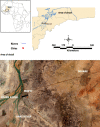Trends in malaria morbidity among health care-seeking children under age five in Mopti and Sévaré, Mali between 1998 and 2006
- PMID: 21067615
- PMCID: PMC2993732
- DOI: 10.1186/1475-2875-9-319
Trends in malaria morbidity among health care-seeking children under age five in Mopti and Sévaré, Mali between 1998 and 2006
Abstract
Background: In Mali, malaria is the leading cause of death and the primary cause of outpatient visits for children under five. The twin towns of Mopti and Sévaré have historically had high under-five mortality. This paper investigates the changing malaria burden in children under five in these two towns for the years 1998-2006, and the likely contribution of previous interventions aimed at reducing malaria.
Methods: A retrospective analysis of daily outpatient consultation records from urban community health centres (CSCOMs) located in Mopti and Sévaré for the years 1998-2006 was conducted. Risk factors for a diagnosis of presumptive malaria, using logistic regression and trends in presumptive malaria diagnostic rates, were assessed using multilevel analysis.
Results: Between 1998-2006, presumptive malaria accounted for 33.8% of all recorded consultation diagnoses (10,123 out of 29,915). The monthly presumptive malaria diagnostic rate for children under five decreased by 66% (average of 8 diagnoses per month per 1,000 children in 1998 to 2.7 diagnoses per month in 2006). The multi-level analysis related 37% of this decrease to the distribution of bed net treatment kits initiated in May of 2001. Children of the Fulani (Peuhl) ethnicity had significantly lower odds of a presumptive malaria diagnosis when compared to children of other ethnic groups.
Conclusions: Presumptive malaria diagnostic rates have decreased between 1998-2006 among health care-seeking children under five in Mopti and Sévaré. A bed net treatment kit intervention conducted in 2001 is likely to have contributed to this decline. The results corroborate previous findings that suggest that the Fulani ethnicity is protective against malaria. The findings are useful to encourage dialogue around the urban malaria situation in Mali, particularly in the context of achieving the target of reducing malaria morbidity in children younger than five by 50% by 2011 as compared to levels in 2000.
Figures



Similar articles
-
Impact evaluation of malaria control interventions on morbidity and all-cause child mortality in Mali, 2000-2012.Malar J. 2018 Nov 14;17(1):424. doi: 10.1186/s12936-018-2573-1. Malar J. 2018. PMID: 30428880 Free PMC article.
-
Acceptability and efficacy of intra-rectal quinine alkaloids as a pre-transfer treatment of non-per os malaria in peripheral health care facilities in Mopti, Mali.Malar J. 2007 May 22;6:68. doi: 10.1186/1475-2875-6-68. Malar J. 2007. PMID: 17519031 Free PMC article. Clinical Trial.
-
Associations between malaria-related ideational factors and care-seeking behavior for fever among children under five in Mali, Nigeria, and Madagascar.PLoS One. 2018 Jan 25;13(1):e0191079. doi: 10.1371/journal.pone.0191079. eCollection 2018. PLoS One. 2018. PMID: 29370227 Free PMC article.
-
Management of uncomplicated malaria among children under five years at public and private sector facilities in Mali.BMC Public Health. 2020 Dec 9;20(1):1888. doi: 10.1186/s12889-020-09873-1. BMC Public Health. 2020. PMID: 33298011 Free PMC article.
-
Rapid reduction of malaria transmission following the introduction of indoor residual spraying in previously unsprayed districts: an observational analysis of Mopti Region, Mali, in 2017.Malar J. 2020 Sep 19;19(1):340. doi: 10.1186/s12936-020-03414-2. Malar J. 2020. PMID: 32950056 Free PMC article.
Cited by
-
Patterns and Determinants of Imported Malaria near the Argentina-Bolivia Border, 1977-2009.Pathogens. 2025 May 28;14(6):537. doi: 10.3390/pathogens14060537. Pathogens. 2025. PMID: 40559545 Free PMC article.
-
Lack of decline in childhood malaria, Malawi, 2001-2010.Emerg Infect Dis. 2012 Feb;18(2):272-8. doi: 10.3201/eid1802.111008. Emerg Infect Dis. 2012. PMID: 22305090 Free PMC article.
-
Dynamics of Plasmodium falciparium and Plasmodium vivax in a micro-ecological setting, Southwest Ethiopia: effects of altitude and proximity to a dam.BMC Infect Dis. 2014 Nov 19;14:625. doi: 10.1186/s12879-014-0625-x. BMC Infect Dis. 2014. PMID: 25407982 Free PMC article.
-
Malaria indicator surveys demonstrate a markedly lower prevalence of malaria in large cities of sub-Saharan Africa.Malar J. 2013 Sep 10;12:313. doi: 10.1186/1475-2875-12-313. Malar J. 2013. PMID: 24021162 Free PMC article.
-
Treatment actions and treatment failure: case studies in the response to severe childhood febrile illness in Mali.BMC Public Health. 2012 Nov 5;12:946. doi: 10.1186/1471-2458-12-946. BMC Public Health. 2012. PMID: 23127128 Free PMC article.
References
-
- Aregawi M, Cibulskis R, Otten M, Williams R, Dye C. World Malaria Report. Geneva: World Health Organization; 2008.
-
- Roll Back Malaria Partnership. The Global Malaria Action Plan for A Malaria-Free World. Geneva: World Health Organization; 2008.
-
- The President's Malaria Initiative. Working with Communities to Save Lives in Africa - Third Annual Report. Washington, D.C.: U.S. Agency for International Development; 2009.
-
- United Nations Department of Economic and Social Affairs. The Millennium Development Goals Report. New York: United Nations; 2009.
MeSH terms
LinkOut - more resources
Full Text Sources
Medical

